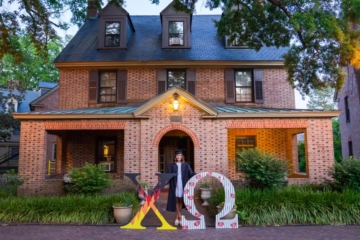The following story originally appeared as an online exclusive for the W&M Alumni Magazine. – Ed.
Sisterhood. It’s a powerful concept that evokes the coming together of women in a family. At William & Mary, one of the ways women have found that sisterhood is through sororities, since almost the very beginning of women’s admittance to the university. Now, sororities at W&M are celebrating 100 years of providing fellowship, leadership and belonging for women.
“Sororities and fraternities are a vibrant part of student life at William & Mary, and one of many ways our students find communities of belonging,” says Vice President for Student Affairs Ginger Ambler ’88, Ph.D. ’06. “Students also develop new skills and practice leadership by serving on chapter committees and as elected officers, by planning events and by participating in local and national service projects. As a member of the Gamma Kappa chapter of Kappa Kappa Gamma at W&M, I’ve found enduring friendships and a network of support that has only grown stronger with time. Our chapter’s centennial this spring will be a joyous reunion.”

In the fall of 1918, the inaugural class of 24 women turned to each other for support as they broke barriers at the nation’s second-oldest institution of higher learning. They quarantined together during the outbreak of Spanish flu and built lasting friendships, an informal sorority of sorts. (For more about the first women at William & Mary, see “One Hundred Years” from the fall 2018 W&M Alumni Magazine.)
Just three years later, on May 30, 1921, Chi Omega became the first officially chartered sorority at William & Mary. Twelve women were part of the original Omicron Beta chapter — founded before even the first women’s athletics team, basketball, was created that winter.
As women’s enrollment at William & Mary grew from those first 24 students to 290 in 1922 (about 40% of the student body), so did the number of sororities. Kappa Alpha Theta’s Beta Lambda chapter came to William & Mary in 1922, followed by Kappa Kappa Gamma’s Gamma Kappa chapter in 1923.
After the first Black undergraduate women were admitted to William & Mary in 1967, historically Black sororities joined the pantheon at the university. The first, the Mu Upsilon Chapter of Delta Sigma Theta, was established in 1976, one year after the first Black fraternity was chartered.
Today, women make up more than 60% of the student body, and there are 13 officially recognized sororities at William & Mary. These sororities are part of the National Panhellenic Conference and the National Pan-Hellenic Council (NPHC), which represents historically African American Greek letter organizations. Nationally recognized sororities with chapters at William & Mary are located on Richmond Road in Sorority Court.

About 24% of undergraduate students at W&M are members of a sorority or fraternity — approximately 2,000 students. When they graduate, they join a community of more than 24,000 W&M alumni who are members.
Since Chi Omega was founded at W&M, more than 2,500 women have been part of the chapter. In April 2021, the sorority launched a yearlong celebration marking the centennial with a virtual event that was broadcast from the Wren Building and attended by about 200 students and alumnae. They also celebrated in person that October during Homecoming & Reunion Weekend 2021, bringing “Chi Os” back to the place they formed those crucial bonds with each other. (See the June 2021 article “Politically Motivated” in the online W&M Alumni Magazine for more about the part Chi O played in the lives of five accomplished alumnae.)
The Gamma Kappa chapter of Kappa Kappa Gamma plans to host a centennial celebration at the W&M Alumni House and across campus March 31-April 2. Students and alumni will come together to reflect on their shared experiences, strengthen their connections with each other and look to the future.
The centennials are also opportunities for alumnae to give back and support current students. The Chi Omega centennial kicked off a fundraising effort for their chapter house, located in Sorority Court, which was built in 1929 and last renovated about four decades ago. While the university provides maintenance and repairs, most chapters also have house renovation funds for philanthropic support of larger projects and upgrades. Funds remaining from the Gamma Kappa weekend will support the Gamma Kappa Scholarship Fund, which awards three scholarships to W&M Kappas per year.

Over the next decade, five more sororities will celebrate 100 years at William & Mary: Pi Beta Phi will reach 100 years in 2025, Phi Mu in 2026, Alpha Chi Omega in 2027, and both Delta Delta Delta and Kappa Delta in 2028. (For a full list of founding dates, see the sororities webpage.)
The W&M community is looking forward to celebrating another important milestone — the creation of the National Pan-Hellenic Council Garden in the Crim Dell Meadow, connecting the Sunken Garden to James Blair Drive and the Sadler Center. The garden will serve as a tangible representation of the historically Black fraternities and sororities on campus, recognizing their legacies, traditions and contributions to the university community. Bricks remaining from the construction of the Hearth: Memorial to the Enslaved will be used in its construction, a nod to the complex history of race at William & Mary.
Eight of the “Divine Nine” NPHC organizations are currently chartered on campus and all nine will be recognized in the garden. As with all sororities and fraternities at William & Mary, students of all ethnicities are welcome to join. The garden project is student-led and donor supported, and $380,000 in gifts is needed to begin construction. To contribute, visit the project website.
“As William & Mary continues to expand its history to be more inclusive, the university has the opportunity to raise the visibility of our historically Black fraternities and sororities and to celebrate their rich legacies and contributions to campus life and society more broadly,” says Chief Diversity Officer Chon Glover M.Ed. ’99, Ed.D. ’06.

Service and contributing to the community are key elements of sorority membership at William & Mary. As well as projects by individual chapters, the fraternity and sorority community has partnered with the Arc of Greater Williamsburg since 1999 to support adults with developmental and intellectual disabilities. Read more about the commitment of W&M NPHC sororities and fraternities to service in this W&M News article.
After graduation, alumni who participated in Greek life, as it was colloquially known for most of its history, continue to give back to William & Mary at higher rates than those who did not participate. In fiscal year (FY) 2022, almost 25% of affiliated alumni made a gift to support W&M’s people, places and programs.
In the spirit of collaboration and competition that exists between chapters, W&M launched a Fraternity & Sorority Alumni Challenge in 2019. All gifts from alumni with these affiliations are automatically counted toward the challenge, in which each chapter competes for the highest percentage of alumni participating (which counts for 90% of their final score) and dollars raised (which counts for 10%). The winning fraternity and winning sorority each year are awarded a trophy at the football game during Homecoming & Reunion Weekend. For FY 2020, Delta Delta Delta won the sorority honors, with Alpha Kappa Alpha rising to the lead in 2021.
Approximately 80 alumni serve as Greek Ambassadors, who reach out to their peers to help them stay connected with each other and William & Mary. To learn more about this program and volunteer, contact May Wells P ’20, director of reunion and affinity annual giving, at mwells01@wm.edu.
Sorority life has continued to evolve in the 100 years since the first chapter was founded with just 12 women. Membership is more inclusive of W&M’s diverse student community, chapters have a stronger focus on service and traditions have evolved — but the strong friendships formed remain the same. Sororities continue to provide the bonds of sisterhood for W&M women as students and throughout their lives.

